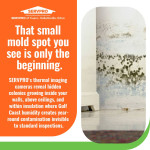Hallettsville, Texas – Advanced thermal imaging technology is helping property owners in South Texas discover hidden mold colonies that traditional visual inspections routinely miss, according to local restoration professionals who respond to mold emergencies throughout the coastal region.
SERVPRO® of Cuero, Hallettsville, Edna has integrated infrared camera technology into its mold detection protocols, allowing technicians to identify moisture patterns behind walls, above ceilings, and within building materials where mold develops unseen. The non-invasive technology reveals temperature differences that indicate moisture retention, guiding targeted mold remediation efforts that address both visible and hidden contamination.
Coastal humidity creates persistent mold threats
The Gulf Coast location creates year-round conditions that promote mold growth in residential and commercial properties. Elevated humidity levels above 60 percent provide the moisture that mold spores require to colonize building materials. Temperature fluctuations between hot summers and mild winters create condensation on cold surfaces, introducing additional moisture into wall cavities, attic spaces, and other vulnerable areas.
Property owners in Cuero, Hallettsville, and Edna frequently discover that small visible mold spots represent only a fraction of actual contamination. Extensive colonies often develop behind bathroom tiles, within wall cavities affected by plumbing leaks, above ceilings where roof damage has introduced water, and in crawl spaces where ground moisture penetrates flooring systems. HVAC ductwork and air handlers accumulate condensation that supports mold growth while distributing spores throughout properties every time systems operate.
Traditional visual inspection methods identify surface mold but cannot detect colonies growing inside building materials. By the time mold becomes visible on interior surfaces, significant colonization has typically occurred in adjacent areas where moisture penetrated drywall, insulation, and framing components. This delayed discovery allows structural damage to worsen and increases the complexity of mold removal projects.
Infrared technology reveals hidden moisture patterns
Thermal imaging cameras detect infrared radiation emitted by all surfaces, creating images that show temperature differences invisible to standard visual inspection. Moisture creates cooler areas on surfaces due to evaporative cooling, and these temperature variations indicate where water has penetrated building materials, even when surfaces appear completely dry.
The technology allows restoration technicians to scan large areas quickly without drilling holes or removing drywall. Cool spots on interior walls signal moisture retention from plumbing leaks, exterior water intrusion, or condensation problems. Temperature differentials around plumbing penetrations identify failed seals and slow leaks that create ideal mold growth conditions. Attic moisture patterns from inadequate ventilation or roof damage appear clearly in thermal images. Foundation moisture intrusion creates distinctive temperature signatures along base plates and lower wall sections.
SERVPRO of Cuero, Hallettsville, Edna uses thermal imaging to document moisture conditions before beginning mold remediation work. The images provide visual evidence for insurance claims and guide precise containment boundaries. After completing mold cleanup, follow-up thermal scans verify that moisture sources have been eliminated and building materials have dried properly. This verification step confirms successful treatment rather than relying on assumptions that visible mold removal solved the entire problem.
Comprehensive mold remediation protocols
Professional mold remediation follows systematic procedures that address detection, containment, removal, and verification. The process begins with a thorough thermal imaging assessment that identifies all moisture anomalies throughout affected properties. Technicians photograph thermal images alongside standard photographs so property owners can see exactly what the technology reveals.
Physical barriers isolate affected areas from the rest of the property, preventing mold spores from spreading during removal activities. Negative air pressure within containment zones ensures air flows into work areas rather than out into clean spaces. HEPA filtration systems capture airborne contaminants continuously throughout the mold removal process.
Eliminating moisture sources represents the most critical step in successful mold remediation. Treating mold without correcting the underlying moisture problem leads to rapid regrowth once conditions become favorable again. Restoration technicians repair plumbing leaks, address roof penetrations, improve ventilation systems, correct foundation moisture intrusion, and resolve HVAC condensation issues before proceeding with mold cleanup.
Porous materials with heavy mold colonization require removal and disposal because thorough cleaning proves impossible. Technicians HEPA-vacuum all surfaces within containment areas, capturing loose spores and debris. Antimicrobial treatments applied to affected areas kill remaining mold and help prevent regrowth during drying. Salvageable materials receive thorough cleaning and sanitization using appropriate products and techniques.
Industrial dehumidifiers and air movers accelerate the drying process while technicians monitor humidity levels and material moisture content throughout treatment. Drying continues until all building materials reach appropriate moisture content levels. Complete drying prevents future mold growth and represents the final step before containment removal and restoration of affected areas to normal use.
Prevention strategies reduce mold risks
Controlling indoor humidity below 60 percent using dehumidifiers, proper ventilation, and air conditioning prevents conditions that support mold growth. Bathroom and kitchen exhaust fans vented to building exteriors remove moisture at its source. Regular HVAC maintenance and filter changes avoid the accumulation of moisture and poor air circulation.
Addressing water intrusion immediately whenever it occurs stops mold colonization before it begins. Professional moisture assessments identify vulnerable areas before problems develop. Property owners who experienced previous water damage or mold issues benefit from annual thermal imaging inspections that detect moisture problems early, when intervention remains simple and inexpensive.
Professional expertise protects property investments.
SERVPRO of Cuero, Hallettsville, Edna emphasizes that thermal imaging technology reveals problems traditional methods miss completely. IICRC-certified technicians follow industry-standard protocols for safe mold cleanup that prevent exposure to dangerous spore concentrations. Proper containment protects the occupant during removal activities and prevents contaminating clean areas. Documentation for insurance claims and property transactions provides evidence that DIY efforts cannot supply. Advanced equipment beyond consumer-grade tools makes the difference between surface treatment and thorough mold remediation that addresses hidden contamination.
About SERVPRO of Cuero, Hallettsville, Edna
SERVPRO of Cuero, Hallettsville, Edna provides advanced mold remediation services using thermal imaging technology for comprehensive detection throughout South Texas properties. The company responds 24 hours a day, seven days a week, including weekends and holidays. IICRC-certified mold remediation specialists serve residential and commercial properties with proven protocols addressing visible and hidden contamination. Services include thermal imaging assessment, proper containment, safe mold removal, moisture source correction, structural drying, and post-remediation verification confirming successful treatment.
Property owners concerned about hidden mold can contact SERVPRO of Cuero, Hallettsville, Edna for advanced thermal imaging inspection and professional services. Call (361) 248-2388 or email office+4@servpro11423.com for assessment scheduling or emergency response. Additional information about mold detection and remediation services is available on their website.



















